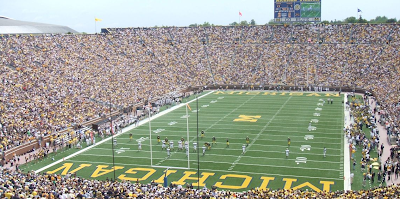Can Purdue Compete? (Guest Post)
Every now and again, someone makes a commet to us and we think it deserves more of a read than just within the comments section...Today, we got one of those.
If you visit here often, you might know 'zlionsfan' as he's a regular commenter. He was thoughtful in his response to J's post, so I thought it warranted a post of its own...so here it is.
Keep in mind, the post isn't exactly in step with what J and I think...but I thought this might cause further discussion. What are your thoughts?
Right now, there's obviously a gap between where Purdue football is right now (a barely-middle-of-the-pack program that struggles to get to bowls) and where we want it to be (perennial contenders). It's becoming very hard to make the case that Hope is still the right guy for the job. Burke isn't likely to make any changes, though, and in any event, he won't find good coaches willing to work for Hope's salary. With Daniels coming on as president, can he get Burke to put more emphasis on growing the football program, or will he let MJB continue to nickel-and-dime his way to bottom-tier bowls?
I don't think Daniels has a choice. The money to build an elite football program simply isn't there, and it isn't ever going to be, not unless he is able to find someone like T. Boone Pickens. (You know, the guy who donated $235 million to Oklahoma State's athletic program.)
Even with a season of sellouts, Purdue would be more than a quarter of a million tickets behind the top of the conference, and something like 100K-200K behind the next tier of stadiums. That's no less than $3M to $6M in revenue that they have no way to collect; of course when you get beyond the cheap seats, it turns out to be a lot more than that.
In 2010, Purdue's football revenue was a little under $18.4M, dead last in the Big Ten. (Check the Revenues and Expenses tab for details.) You can probably see where this is going: Indiana's was about $24.2M. Iowa, in the middle of the conference, was $44.5M. Penn State and Michigan topped $70M.
Basically, the conference elites make $60M-$70M ... but that's the result of decades of planning, support, and success. Beaver Stadium's capacity exceeded 80,000 in 1970; Ohio Stadium in 1960; Michigan Stadium in 1928. They were both lucky and wise, Michigan in particular: it was a lot cheaper to expand stadiums in the '50s and '60s than it is today. (Of course, renovations of a 100,000-seat stadium are expensive, too.) And it doesn't make sense to proceed with Phase II and III of the Ross-Ade expansion when Purdue doesn't even sell out now.
I think it's reasonable to not be satisfied with catching and dominating the middle of the pack, but even for that, money is going to have to come from somewhere. Higher attendance will make up a little of the difference, but that still translates to IU- or Northwestern-level revenue. High-end JPC members can kick in some money. Where's the rest going to come from?
In 2010, the cheapest adult ticket to the highest-demand home game cost $46. This was about 25% cheaper than the mean Big Ten price for similar games (right about $60). Burke has been working on department-wide measures to build and maintain a significant student presence, but that just deals with attendance, not revenue. How can a school with a low-capacity stadium and cheap tickets significantly build its revenue?
Well, it's hard. Revenue is suffering because of a lack of success, relative importance (basketball's obviously first here, and with good reason), and other factors. Raising attendance by dropping ticket prices is tricky: you don't want to lose revenue just to try to fill the seats. Raising prices isn't going to work unless you can point to a specific plan, and really, would we believe Burke if he laid one out? Hiring a marquee coach isn't going to happen without the revenue, and even a second-tier coach will think twice about coming here unless there's a plan in place to boost attendance ... which generally is going to require increased success. (And in the Big Ten, revenue is really about attendance: success itself doesn't help that much, because you're going to get a share of the bowl pool no matter what you put into it.)
Burke deserves criticism for not trying harder to build the program with the money he has available (Purdue had about $7M in "profit" from the 2010-11 season; no telling what it was earmarked for, though). Extending Hope because he'll work for next to nothing was a bad move. The root of the problem is deeper than that, and as much as it pains me to admit, it's likely beyond the ability of Burke and Daniels to change.
However, they can at least make a start. Big-name coaches are not going to take a major pay cut to coach at a school with adequate facilities and a frustrated fan base, but there are up-and-coming coaching candidates available every year; all it takes is one of them who'll be willing to prove himself here. Find someone who can build a decent program at Purdue ... but don't make a long-term commitment to someone just because he's cheap. Give the next guy a few years, and if he doesn't work out, keep moving on until one does. Get the program back to where it was in Tiller's heyday, and maybe then, we'll start to see opportunities to close the revenue gap that is currently making it a challenge to keep up with Indiana and Northwestern, never mind Michigan and Ohio State.
